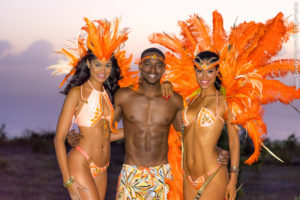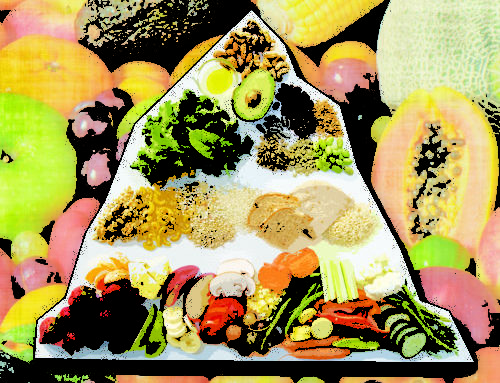By: V’La Gonzales
As the airplane approaches the luscious green north coast of Trinidad, a mystical island emerging from the dazzling Caribbean Sea welcomes you. A few moments later you are over Port of Spain, the capital. It’s twinkling lights an alluring panorama of parties, intrigue, and adventure. It’s Carnival time in Trinidad.
Welcome to the land of insomnia. Energy is vital. Sleep is not an option. This mecca heralds the sunrise as parties unfold 24/7. A culture whose mantra is “ Trini’s love to party, Trini’s love to fete.” Trinidadian faces, all shapes, and colors, beautiful, erotic and exotic, daring you to shed your inhibitions, to dance, to free up. Your participation hinges on your ability to partake in art and pleasure.
 The beauty of Trinidad’s Carnival is its soul, rooted in the people’s joy, artistry, and melancholy. It’s spirit shaped by African rituals of power and rebellion, employing the mask, mystical and enchanting melodies, and the will to be free. Art for art’s sake, any theme will do. It’s breath-taking pageantry choreographed in villages and towns throughout the island — their goal: a climactic explosion of dazzling color in the streets on Carnival Day, ranting and raving, extracting every drop of nectar from the jump up. Women rule, their brilliance, virtuous and free.
The beauty of Trinidad’s Carnival is its soul, rooted in the people’s joy, artistry, and melancholy. It’s spirit shaped by African rituals of power and rebellion, employing the mask, mystical and enchanting melodies, and the will to be free. Art for art’s sake, any theme will do. It’s breath-taking pageantry choreographed in villages and towns throughout the island — their goal: a climactic explosion of dazzling color in the streets on Carnival Day, ranting and raving, extracting every drop of nectar from the jump up. Women rule, their brilliance, virtuous and free.
The whole nation is absorbed in the bacchanal. The thunder of the minor chords from the steel orchestras, nestled under the moonlight, enters your heart with melodic ecstasy. The Calypso Tents are where the world’s most celebrated raconteurs dispense sweet melodies and thought-provoking anecdotes on any subject. Massive all night fetes, catering to patrons in the thousands, jam to mesmerizing Soca rhythms. Countless rum shops, restaurants, bars, roadside vendors and malls supply fuel for the unceasing energy of the night. Modern-day Trinidad is a vibrant metropolis with all the trappings of a wealthy tropical paradise. Citizens are alive with lyrics that caress and elevate your moment of encounter. An abundance of oil, natural gas and asphalt are the foundation of their booming economy — a perfect setting for art and culture to flourish.
 Sometime during the day, the Friday before Carnival, I would suggest that you escape the city for a few hours to enjoy Maracas Bay. Not only is the ride over the scenic north coast exhilarating, with its narrow road zigzagging through a dense and luscious forest, but the water is also very refreshing, and you can treat yourself to delicious Trini style food from the restaurants located on the beach. On Carnival Monday and Tuesday there are countless masquerade bands to choose from to play mas. Most mas bands offer an all-inclusive package for a few hundred dollars consisting of costume, food, and drinks. This is the recommended way to go because the jump-up routes are long and last for most of the day.
Sometime during the day, the Friday before Carnival, I would suggest that you escape the city for a few hours to enjoy Maracas Bay. Not only is the ride over the scenic north coast exhilarating, with its narrow road zigzagging through a dense and luscious forest, but the water is also very refreshing, and you can treat yourself to delicious Trini style food from the restaurants located on the beach. On Carnival Monday and Tuesday there are countless masquerade bands to choose from to play mas. Most mas bands offer an all-inclusive package for a few hundred dollars consisting of costume, food, and drinks. This is the recommended way to go because the jump-up routes are long and last for most of the day.
At 4 AM Jouvert morning, the bell rings, and the carnival rooster crows announcing the beginning. Suddenly out of the darkness, Trinidad and Tobago begin the ritual that rekindles their emancipation and heralds in the dawn of a long-awaited celebration. The music, a mystical magnet that ignites and liberates a night that makes way for the joy of tomorrow.
 Around noon, as the sun reaches the highest point in the sky, the Jouvert revelers pass the tempo over to the Monday masqueraders. My music of choice during the Jouvert and Monday jump-up is the steel orchestra. However, there is no stopping the big brass bands nestled on the Big Trucks, with booming speakers as they dominate the sound in the streets.
Around noon, as the sun reaches the highest point in the sky, the Jouvert revelers pass the tempo over to the Monday masqueraders. My music of choice during the Jouvert and Monday jump-up is the steel orchestra. However, there is no stopping the big brass bands nestled on the Big Trucks, with booming speakers as they dominate the sound in the streets.
On Carnival Tuesday, when your mas band takes the spotlight on the grand stage, the tropical energy revs up spinning out pageantry of choreographed colors. This is euphoria, your moment to show the world how to play mas, how to rant, wave and misbehave. As the sun sets, and midnight only a few hours away, you can depend on the big brass bands with riveting horns to push your feet to the climax of another Carnival in paradise. Spend an hour, a day, a week, or the rest of your life – go. Experience the sweetness of Trinidad and Tobago…you will see why the locals say that “God is a Trini.”
Note: This article was originally published in the inaugural issue of Bronzeville Life Vol. 1 for August/September 2018.




Leave A Comment